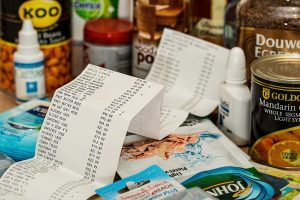$150 Groceries?! The Sneaky Science of Supermarkets
by Julia Cobb, Student in SEE-U NYC: Agro-eco/Food Systems Course

Camembert called to me.
I needed her. And Parmigiano Reggiano. And Cave-Aged Gruyère. And Red Wax Gouda. Or so I explained to my boyfriend as I sampled yet another slice. “Just one more,” I promised.
It wasn’t just one more. Soon I had sampled four different cheeses, then salami, then before I knew it, we were leaving with half a pound of regret. It wasn’t even a cheese tasting. It was a supermarket.
Sound familiar?
Every facet of a supermarket, from the moment you walk through the door, is designed to get you to buy as much as possible. It quite literally starts at the door, which is typically a one-way entry door. To exit, you have to walk by all sorts of tempting displays (more on that later).
Once you’ve walked in, you’re in what retail psychologists refer to as the “decompression zone.” This section of the supermarket is meant to make you calm and comfortable with your surroundings. The scent of fresh bread and flowers tickles your nostrils – pleasant, familiar aromas like you’re back at Grandma’s house. There’s a reason the bakery and the flowers are right by the door.
Then you’re in the produce section. You feast your eyes on glistening red apples, luminescent bananas. Delicious, right? Extra delicious thanks to very intentional lighting, which is why your tomatoes usually look better on the shelf than on your counter. You may also notice someone spraying water on the produce periodically. This gives the produce a dewy fresh look, like that of a swimsuit model in a photo shoot. The spraying is purely for aesthetic purposes; it actually makes the produce rot faster.
You doggedly head forward, determined to get your milk and just your milk. Dairy products are at the very end of the store, past a wide array of temptations. Popular items – in the middle of the aisle so you have a chance to be distracted. This is called the “thigh to eye” zone and it’s just as intentional as the sultry produce lighting; food manufacturers pay to have their food placed here. Strategic placement, like the “end caps,” the displays at each end of the aisle, can cost food companies up to $1 million. These displays are the ones you see first when you’re trying desperately to get your milk or your eggs or whatever it was that your mom wanted you to buy.
All of this- it’s all delaying tactics. The more products you see, the more you’ll be willing to buy. And there’s a reason there aren’t usually clocks or windows in supermarkets; you’re meant to lose track of time. After 40 minutes of shopping, you’ll stop making decisions based on rationality and will start making decisions purely emotionally. That’s when the 50% of stuff we never intended to buy happens. That’s when the cheese comes in.
“Not I,” you insist, “I am a creature of reason and cannot be fooled.” Okay, maybe you haven’t bought more than you can chew, but you’ve definitely been at least…moderately manipulated. Do you start shopping at the right side of the store, and generally work your way along the outer rim toward the register (perhaps stopping for samples or to look at other products if you’re feeling less reasonable that day)? That route is one that is chosen for you; the majority of people generally stick to a counter-clockwise route, courtesy of the supermarket, because it makes it easier for right-handed people (9 out of 10 people) to put groceries in their carts.
A little demoralizing? Supermarkets are just like any other retail store; they have to make a profit. And you can’t blame them- they may be a dying species, thanks to the threat of e-commerce. Is that a good thing…? Is online food shopping a good thing…? And how does this all relate to food and health? Stop by my next blog post to find out!
References
Dornsife, D., Dornsife, D., 2018. The psychology of the grocery store. A look at consumer behavior. University of Southern California. https://appliedpsychologydegree.usc.edu/resources/infographics/psychology-of-the-grocery-store/ (July 20, 2018).
Brinkworth, C., 2017. Supermarket savvy: An analysis of psychological exploitation within grocery stores. Independent Study Project Collection. 2603. S.I.T. Grad. Instit. http://digitalcollections.sit.edu/cgi/viewcontent.cgi?article=3623&context=isp_collection (July 20, 2018).




Submit Comment